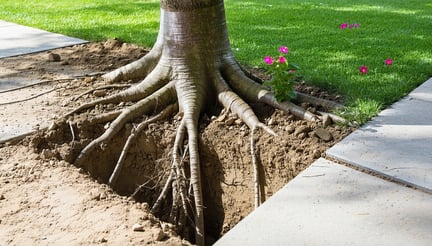Introduction: The Hidden Threat Beneath Your Feet

Trees are majestic, life-giving additions to any landscape—but their roots? Not so innocent.
Whether you're a homeowner, landscaper, contractor, or city planner, you’ve likely encountered the unwanted impact of invasive tree roots: cracked sidewalks, uneven patios, ruptured sewer lines, and even foundation damage.
The fix? Enter the HDPE (High-Density Polyethylene) liner—a surprisingly underused material that makes for one of the most effective and durable artificial tree root barriers available today.
In this blog, we'll explore:
-
Why tree root intrusion is such a serious problem
-
What traditional barriers get wrong
-
Why HDPE liners are a game-changer
-
How to install them (with real-world tips)
-
Where to buy HDPE for root control
-
Bonus: Use cases beyond residential landscaping
🌱 The Problem: Tree Roots Go Where They Please
Tree roots are designed by nature to search for water and nutrients. They don’t care if your sewer pipe, driveway, or home foundation is in the way.
Over time, even small roots can:
-
Crack concrete and asphalt
-
Lift sidewalks and pavers
-
Wrap around pipes, strangling or cracking them
-
Break through basement walls or foundations
What’s worse? Cutting back the roots won’t solve the problem—it can actually damage the tree and trigger aggressive new root growth.
🧱 Traditional Root Barriers: Why They Fail
Many people still use temporary or low-cost materials like:
-
Fabric weed barriers
-
Thin plastic sheets
-
Metal panels
-
Concrete footers
The problem?
-
Most degrade or crack over time
-
Tree roots eventually pierce or grow around them
-
They’re expensive to repair or remove
-
They may lack flexibility for curved designs or varying soil types
These materials provide a false sense of protection—especially in high-root-pressure areas.
🛡️ HDPE Liners: The Modern Solution for Root Defense
HDPE (High-Density Polyethylene) liners are often associated with landfills, pond liners, or environmental containment projects. But their strength, chemical resistance, and flexibility make them perfect for long-term root barrier applications.
✅ Key Benefits of HDPE Root Barriers:
1. Unmatched Durability
-
Resists punctures from even the most aggressive root systems
-
Won’t degrade or become brittle like fabric or PVC
-
Can last 50+ years underground
2. Moisture & Chemical Resistant
-
Roots are drawn to water and nutrient-rich areas
-
HDPE provides a completely impermeable surface, cutting off that draw
3. Flexible Yet Rigid Enough
-
Comes in various thicknesses (40 mil, 60 mil, etc.)
-
Can be shaped around corners or cut to match trench depth
4. Environmentally Safe
-
Inert and non-toxic
-
Does not leach chemicals into the surrounding soil
-
Recyclable at end-of-life
5. Cost-Effective in the Long Run
-
Reduces need for root pruning, pipe repair, and sidewalk replacement
-
A one-time investment that protects for decades
🛠️ How to Install HDPE Root Barriers – Step-by-Step
The great thing about HDPE root barriers is they’re relatively easy to install, even for DIYers or landscapers with basic trenching tools.
Step 1: Plan the Line
-
Choose how far from the tree you want to protect
-
Recommended distance: 3 to 5 feet from structures
-
Barriers can be placed in a straight line or wrap around planting areas
Step 2: Dig a Trench
-
Depth: Minimum 24 inches, but go deeper if dealing with mature trees
-
Width: Just wide enough to accommodate the HDPE sheet vertically
Step 3: Place the HDPE Sheet Vertically
-
Leave 1 to 2 inches exposed above ground to deter surface root overgrowth
-
Overlap sheets by 6–12 inches if using multiple panels
Step 4: Backfill and Compact
-
Use original soil or soil mixed with gravel/sand for drainage
-
Compact gently to stabilize the sheet
Step 5: Monitor and Adjust
-
Check the exposed portion seasonally
-
Trim surface roots if they attempt to grow over the top
🏘️ Real-World Applications
🔨 Homeowners:
Protect your foundation, driveway, and patios from aggressive species like ficus, bamboo, or willow.
🏙️ City Planners:
Install barriers along public walkways, roads, and utility easements to prevent costly public infrastructure damage.
🌳 Landscapers:
Offer HDPE root barrier installation as a premium service—especially in high-end residential or commercial projects.
🧑🌾 Nurseries & Farms:
Use barriers to control spread of rootstock or manage water usage zones.
📦 Choosing the Right HDPE Liner for Tree Root Barriers
Recommended Specs:
-
Thickness: 40 mil to 60 mil for residential use; 80 mil for high-pressure areas
-
Height: Depends on tree type and growth; 24"–48" typical
-
Textured or Smooth: Textured liners may provide better friction hold in some soils
Pro tip: Buy HDPE liners with UV resistance if any portion will be exposed to sunlight.
Where to Buy:
-
Specialty retailers like Global Plastic Sheeting 866.597.9298
💡 Bonus: Additional Creative Uses for HDPE in Landscaping
-
Retaining moisture in garden beds
-
Lining raised planter boxes
-
Creating underground water channels
-
Isolating invasive plants (like bamboo or mint)
-
Lining decorative water features
🔚 Conclusion: The Smarter Way to Stop Tree Root Intrusion
Tree roots don’t care what’s in their way—but you can.
Whether you're dealing with delicate landscaping or major infrastructure, HDPE root barriers offer unbeatable protection that outperforms fabric, metal, or concrete alternatives. With simple installation, long-term durability, and environmental safety, HDPE is the modern landscaper’s secret weapon.
So next time you're battling unruly roots, skip the guesswork and go for a proven solution:
HDPE root barriers—simple, strong, and smart.


